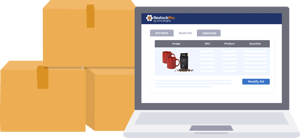Originally published on September 28, 2020, updated January 20, 2025
Menu
Join Our Email List
- Receive our monthly newsletter.
- Stay up to date on Amazon policies.
- Get tips to grow your business.
Bundles have been a popular sales strategy in brick-and-mortar stores for years. The idea is simple: sell a group of different products together as a single unit, typically with a price discount. Not only does this add extra incentive to buy, but also it lets you unload more inventory at the same time.
The trouble has been translating this technique to eCommerce. With online sales where everything is digitized, you can’t always just make and add a new product code for a bundle and sell them alongside the individual units — it can mess up stock levels or confuse your inventory data, not to mention the additional complications when different products are stored in different facilities.
Luckily, you can use RestockPro to build and manage bundles and kits for your Amazon business.
Amazon has also released a virtual product bundles tool for FBA sellers. However, because it’s still in beta, there are some wrinkles in how it works, not to mention other requirements. Here is a quick guide to help you understand what it can do, what you need, and some best practices for using it yourself.
Essentially, the Amazon virtual bundles tool allows you to sell multiple products together as a single unit. There are still some fine details about what you can and can’t sell, which we discuss in the next section.
Each virtual product bundle revolves around a “main component.” This is typically the most popular product in your bundle, or perhaps the cornerstone in a thematic grouping (i.e., a book on how to paint, bundled with painting supplies). The main component is the only item that features the bundle widget on its product page; the other product pages don’t mention it, at least not yet.
 One of the best advantages of Amazon virtual bundles is the option for discounting — you’re free to set a special price for bundles as opposed to the price for the products on their own. This is a powerful marketing tool in incentivizing shoppers to buy more products, particularly bargain-hunters. It’s also worth mentioning that you can create coupons and A+ content for Amazon bundles. Amazon requires that the price of bundles must be equal to or less than the sum of the individual products.
One of the best advantages of Amazon virtual bundles is the option for discounting — you’re free to set a special price for bundles as opposed to the price for the products on their own. This is a powerful marketing tool in incentivizing shoppers to buy more products, particularly bargain-hunters. It’s also worth mentioning that you can create coupons and A+ content for Amazon bundles. Amazon requires that the price of bundles must be equal to or less than the sum of the individual products.
FBA fulfillment fees remain standard for each item in a virtual bundle. Because each item is still handled individually, the per-item fees stay the same. Note: If you create a bundle without using this program, the referral fee for the category used to list the product applies to the entire bundle.
Individual items from virtual product bundles can be returned separately. If your bundle included a discounted item, customers will receive a prorated refund after returning the item.
Moreover, all Amazon bundles are unique ASINs with their own separate reviews and ratings. This can be a double-edged sword: while you can’t take advantage of a single product’s high rating, it can give a much-needed fresh start to a product with a low rating.
There are some downsides and restrictions for virtual product bundles, though. For starters, the tool is only available on Amazon.com, so international sellers will have to wait a little longer. Furthermore, the virtual product bundle widget on the main component page only appears on the desktop site, limiting its effect on mobile shoppers.
On top of that, virtual product bundles don’t show up on standard sales reports, so your analytics may be skewed. To compensate, Amazon sends a special sales report about once a week to list the performance of your bundles, so you can strategize and plan accordingly.
If you’re interested in selling virtual product bundles on Amazon, you’ll need to read the fine print. At the moment, not everyone can use this tool, and not every product can be incorporated.
For sellers, there are two requirements. First, you need to be using FBA (Fulfillment by Amazon), as this is a service provided by FBA fulfillment centers. Second, you need to be a member of the Amazon Brand Registry, which is to say, you need to own your own seller brand.
You can’t just throw together any combinations of products. The following products are restricted and can not be used in bundles:
Each bundle must have a minimum of two unique ASINs. That means you can’t sell bundles of the same product, i.e., four bottles of the same hand cream. However, you can sell four bottles of the same hand cream along with a lip balm in the same bundle — the lip balm and hand cream are both unique ASINs, meeting the minimum requirement of two.
Want to use product bundles like an expert seller? Here are some quick tips on getting the most out of this tried-and-true sales strategy.
Choosing the bundle’s main component is a crucial decision. Consider picking the most popular product in your bundle to leverage its visibility. The more people who visit that product page, the more people who see the bundle widget — its essentially free advertising for an upsell. You can take advantage of this to get eyes on your lesser-known products.
Unsold inventory costs money, especially considering FBA’s fees on long-term storage. If you’re at the point of cutting your losses and selling those items at a discount, virtual product bundles are a great way to unload them. You can leverage the visibility of more popular items, explained above, and “tack on” less-popular items as more of a special gift. The amount you save in storage fees might even make up for what you lose with the discount.
 As we mentioned above, two of the biggest problems with eCommerce bundles are managing stock and analytics. If you use inventory management software like RestockPro, you can circumvent these issues altogether. RestockPro can track bundles as individual units while simultaneously keeping tabs on the individual stock levels, so you never risk overselling or running out of stock. You can create, manage, and break bundles with the Kitting Optimizer in RestockPro.
As we mentioned above, two of the biggest problems with eCommerce bundles are managing stock and analytics. If you use inventory management software like RestockPro, you can circumvent these issues altogether. RestockPro can track bundles as individual units while simultaneously keeping tabs on the individual stock levels, so you never risk overselling or running out of stock. You can create, manage, and break bundles with the Kitting Optimizer in RestockPro.
Furthermore, you don’t have to wait for a special bundle sales report from Amazon — you can check your bundles’ performance at any time in RestockPro. The Amazon Brand Registry requirements do not apply to bundles created with RestockPro, so you can build and manage bundles regardless of your Brand Registry status.
Originally published on September 28, 2020, updated January 20, 2025
This post is accurate as of the date of publication. Some features and information may have changed due to product updates or Amazon policy changes.
These Stories on Inventory
14321 Winter Breeze Drive
Suite 121 Midlothian, VA 23113
Call us: 800-757-6840





Copyright© 2007-2025 eComEngine, LLC. All Rights Reserved. eComEngine®, FeedbackFive®, RestockPro®, and SellerPulse® are trademarks or registered trademarks of eComEngine, LLC. Amazon's trademark is used under license from Amazon.com, Inc. or its affiliates.
No Comments Yet
Let us know what you think